Howdy Doody/ Classic TV (original) (raw)
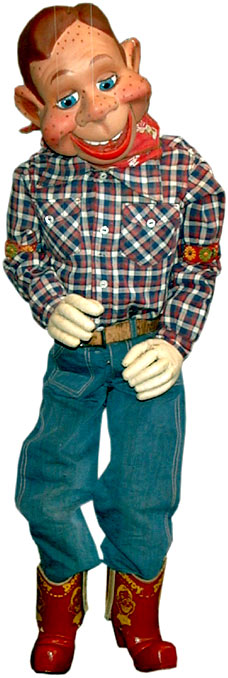
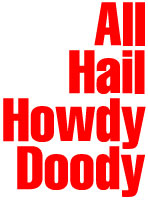
by L. Wayne Hicks
He was the perfect presidential candidate: likeable, youthful and opinionated. So what if his handlers jerked him around like a puppet on a string? That was part of his charm.
The candidacy was one for the history books; never before had someone from the world of television strived for the presidency. If Pinnochio could dream of being a real boy, then why couldn't another wooden boy aspire to become president of the United States?
Howdy Doody wasn't a serious candidate, of course, and his constituency was limited to a select group of Americans - the children - but the campaign proved to be a clever gambit to hide a particularly trying time in the history of the show.
Like many other programs from the early days of television, what became "The Howdy Doody Show" sprang from radio. Buffalo-born disc jockey Bob Smith broadcast from NBC's New York radio station WEAF. His patter sometimes included a cornpone character named Elmer who greeted people with the words "Well, howdy doody." Picked to lead a children's program on the NBC Eastern network, Smith became "Buffalo Bob" and brought the unseen Elmer with him, rechristening him "Howdy Doody."
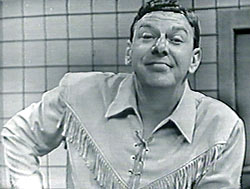 "We talked with NBC on a Tuesday, and they wanted the show to air on Saturday," Smith told People in 1987, 40 years after the show made its debut. "We didn't even have a puppet. I said, 'You know, kids, we have a little fella named Howdy Doody, and Howdy wanted to be with me tonight and, well, he just got too bashful, and he is in my desk drawer right here.' Howdy was too bashful for three weeks."
"We talked with NBC on a Tuesday, and they wanted the show to air on Saturday," Smith told People in 1987, 40 years after the show made its debut. "We didn't even have a puppet. I said, 'You know, kids, we have a little fella named Howdy Doody, and Howdy wanted to be with me tonight and, well, he just got too bashful, and he is in my desk drawer right here.' Howdy was too bashful for three weeks."
When Howdy finally made his television debut, on the fourth show, Jan. 17, 1948, and Smith recalled, he looked "very, very crude. He was ugly. Just terrible."
He looked nothing like how people remember Howdy today. Created by Frank Paris, Howdy was a goofy looking thing, with jug ears, a mop of orange hair and a big grin. He looked more like an Elmer. In other words, he fit the voice.
Broadcast from NBC's Studio 8A, the show originally was called "The Puppet Playhouse." NBC ran the show commercial-free because no sponsor had signed up yet. Initially on for an hour every Saturday evening, the program expanded to fill an hour three days a week. Within the year, the renamed "Howdy Doody Show" was on every weekday.
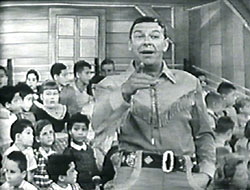 "The Howdy Doody Show" remains fixed in the mind today for Buffalo Bob's greeting - "Say, kids. What time is it?" - and the answer: "It's Howdy Doody Time" that sprang forth from the 40 or so kids squeezed in the studio's "peanut gallery."
"The Howdy Doody Show" remains fixed in the mind today for Buffalo Bob's greeting - "Say, kids. What time is it?" - and the answer: "It's Howdy Doody Time" that sprang forth from the 40 or so kids squeezed in the studio's "peanut gallery."
Smith originally dressed as a ringmaster, and the show bore a circus theme. Smith supplied the voice for Howdy, quickly spoiling the illusion for members of the peanut gallery.
Smith pulled some of his radio helpers over to the television studio. A former NBC page named Bob Keeshan, who was keeping busy running to the New York Public Library to look up historical facts for Smith, came along as an assistant. He handed out prizes. Outfitted in a sportscoat, Keeshan didn't fit in with the circus theme, so he was costumed as a silent clown named Clarabell. Smith slipped him $5 a show.
Eddie Kean, a gag writer recently back from service in World War II, was put to work on the new television show. Paid 75forthatfirstshow,SmithgaveKean75 for that first show, Smith gave Kean 75forthatfirstshow,SmithgaveKean25 of that to write.
Kean began working with Smith in September 1947, when Smith's writer on the radio show left for six months. Kean filled in, churning out gags for Smith's daily, 6-10 a.m. show. Kean said in an e-mail interview that Howdy Doody "unpredictably grew from an intended one-shot Christmas 'special' into what it became" and kept busy on both TV and radio shows. He stuck to Howdy Doody once Smith's old writer returned to the radio show. Kean served as the solo writer for the television show during its first seven years (the show finally left the air in 1960).
"Nearly 2,000 scripts was enough," Kean said.
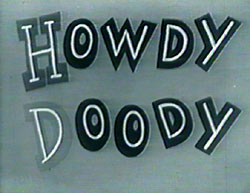 "Howdy Doody" quickly caught on, despite its limited audience. The NBC Eastern network only reached six cities - New York, Boston, Schenectady, Philadelphia, Washington and Baltimore, but when "Howdy Doody" was on, kids crammed into the homes of whoever had a television set to watch.
"Howdy Doody" quickly caught on, despite its limited audience. The NBC Eastern network only reached six cities - New York, Boston, Schenectady, Philadelphia, Washington and Baltimore, but when "Howdy Doody" was on, kids crammed into the homes of whoever had a television set to watch.
Humor writer Dave Barry summed up the influence Howdy had on the baby boomers in his book Dave Barry Turns 50: "We sang the Howdy Doody song and we nagged our parents incessantly to buy the many items of Howdy Doody merchandise advertised on it. They could have advertised the official Howdy Doody edition of all sixteen volumes of Remembrance of Things Past by Marcel Proust in the original French, and we would have begged our parents for it."
The devotion to Howdy Doody was put to the test early on. As the show stretched across more days, Kean was forced to find new ways to fill the hours. He decided to have Howdy run for president. It was an election year, after all.
HOWDY: You know, the kids never have a chance to vote for anybody.
BUFFALO BOB: Well, I know Howdy, but you see, you have to be over 21 to vote.
HOWDY: Yeah, well, that's not fair. That's why I'm just running for president of the kids.
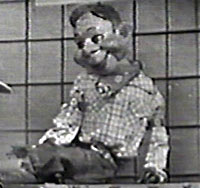
NEXT: Part Two: (Like any good politician, Howdy told the children what they wanted to hear, promising two Christmas holidays but just one school day a year and more pictures in history books.)